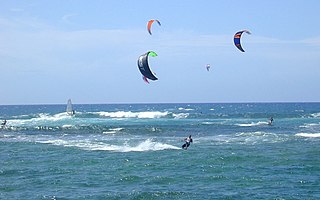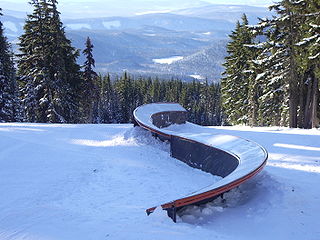
Winter sports or winter activities are competitive sports or non-competitive recreational activities which are played on snow or ice. Most are variations of skiing, ice skating and sledding. Traditionally, such games were only played in cold areas during winter, but artificial snow and artificial ice allow more flexibility. Playing areas and fields consist of either snow or ice.
Boardsports are active outdoor sports that are played with some sort of board as the primary equipment. These sports take place on a variety of terrains, from paved flat-ground and snow-covered hills to water and air. Most boardsports are considered action sports or extreme sports, and thus often appeal to youth. Some board sports were marginalized in the past. However, many board sports are gaining mainstream recognition, and with this recognition, they have enjoyed wider broadcast, sponsorship and inclusion in institutional sporting events, including the Olympic Games.
Freestyle skiing is a skiing discipline comprising aerials, moguls, cross, half-pipe, slopestyle and big air as part of the Winter Olympics. It can consist of a skier performing aerial flips and spins and can include skiers sliding rails and boxes on their skis. Known as "hot-dogging" in the early 1970s, it is also commonly referred to as freeskiing, jibbing, as well as many other names, around the world.

Kiteboarding or kitesurfing is a sport that involves using wind power with a large power kite to pull a rider across a water, land, or snow surface. It combines the aspects of paragliding, surfing, windsurfing, skateboarding, snowboarding, and wakeboarding. Kiteboarding is among the less expensive and more convenient sailing sports.

A power kite or traction kite is a large kite designed to provide significant pull to the user.

Børge Ousland is a Norwegian polar explorer. He was the first person to cross Antarctica solo.

Kite landboarding, also known as land kiteboarding or flyboarding, is based on the sport of kitesurfing, where a rider on a surf-style board is pulled over water by a kite. Kite landboarding involves the use of a mountain board or landboard, which is essentially an oversized skateboard with large pneumatic wheels and foot-straps. Kite landboarding is a growing sport, and there are several competitions. Kite landboarding is attracting growing publicity although it is not yet as popular or as well known as kitesurfing.

Peter Lynn is a New Zealand kitemaker, engineer and inventor. He is notable for his construction of the world's largest kites, giant inflatable (sparless) display kites, the popularisation of kite buggying and contributions to the development of power kiting and kitesurfing. He spends much of the year travelling worldwide and displaying his kites at International Kite Festivals.

Bow kites are leading edge inflatable kites that incorporate a bridle on the leading edge. They are used for the sport of kiteboarding. They can be identified by a flat, swept-back profile and concave trailing edge allowing the kite greater depower. Bow kite design was pioneered by Bruno Legaignoux, and have been licensed to many kite manufacturers. The first major manufacturer to introduce these bow kites to the United States was Cabrinha Kites.

The following outline is provided as an overview of and topical guide to skiing:
Supported leading edge kite (SLE) is a type of power kite used mainly for kitesurfing.

Bruno Sroka is a French male kitesurfer and adventurer. He is 3 times winner of the World Cup as well as 3 times European Champion in course racing. Bruno Sroka is the first and only man that crossed the Cape Horn by kitesurf and the first one that realized the unique Way of Peace project in the Gulf of Aqaba.
The Willis Resilience Expedition was a scientific and exploratory program that took place in Antarctica from November 2013 to January 2014, with the goal of a better understanding of changes in the Earth's climate brought on by global warming in addition to weather-related risk. Announced in August 2013, the expedition was led by explorer Douglas Stoup and Parker Liautaud, a teenage polar adventurer and environmental campaigner. The expedition was underwritten by Willis Group, a global risk advisor, insurance and reinsurance broker.
Kiteboarding is a water-based, kite-powered sport Kiteboarding may also refer to:
Kite rigs are wind-assisted propulsion systems for propelling a vehicle. They differ from conventional sails in that they are flown from kite control lines, not supported by masts.
This glossary of skiing and snowboarding terms is a list of definitions of terms and jargon used in skiing, snowboarding, and related winter sports.

Wing foiling or wing surfing or winging is a wind propelled water sport that developed from kitesurfing, windsurfing and surfing. The sailor, standing on a board, holds directly onto a wing. It generates both upward force and sideways propulsion and thus moves the board across the water. The recent development of foilboards, which plane very early on a hydrofoil fin and thereby lift off the water producing low friction, represent the ideal complementary hydrodynamic platform for wings. This young sport is poised to become wildly popular.













